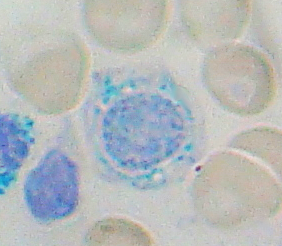X-linked sideroblastic anemia and spinocerebellar ataxia
Editor-In-Chief: Prab R Tumpati, MD
Obesity, Sleep & Internal medicine
Founder, WikiMD Wellnesspedia &
W8MD medical weight loss NYC and sleep center NYC
| X-linked sideroblastic anemia and spinocerebellar ataxia | |
|---|---|

| |
| Synonyms | XLSA/A |
| Pronounce | |
| Specialty | Hematology, Neurology |
| Symptoms | Anemia, Ataxia, Fatigue (medical), Dizziness |
| Complications | N/A |
| Onset | Childhood |
| Duration | Lifelong |
| Types | |
| Causes | Genetic mutation in the ABCB7 gene |
| Risks | Family history of the condition |
| Diagnosis | Genetic testing, Blood test, Bone marrow biopsy |
| Differential diagnosis | Other forms of sideroblastic anemia, other causes of ataxia |
| Prevention | Genetic counseling |
| Treatment | Vitamin B6 supplementation, Blood transfusion, Physical therapy |
| Medication | |
| Prognosis | Variable, depends on severity |
| Frequency | Rare |
| Deaths | |
A rare genetic disorder affecting blood and nervous system
X-linked sideroblastic anemia and spinocerebellar ataxia (XLSA/A) is a rare genetic disorder characterized by the combination of sideroblastic anemia and spinocerebellar ataxia. This condition is caused by mutations in the ABCB7 gene, which is located on the X chromosome. The disorder primarily affects males, as they have only one X chromosome, while females may be carriers and are usually asymptomatic.
Genetics[edit | edit source]
XLSA/A is inherited in an X-linked recessive manner. The ABCB7 gene encodes a protein that is part of the ATP-binding cassette (ABC) transporter family. This protein is involved in the transport of iron-sulfur clusters from the mitochondria to the cytosol, which is crucial for various cellular processes, including heme synthesis and iron homeostasis. Mutations in the ABCB7 gene disrupt these processes, leading to the accumulation of iron in the mitochondria and the development of sideroblastic anemia.
Clinical Features[edit | edit source]
The clinical presentation of XLSA/A includes two main components:
Sideroblastic Anemia[edit | edit source]
Sideroblastic anemia is characterized by the presence of ringed sideroblasts in the bone marrow. These are erythroblasts (immature red blood cells) with iron-loaded mitochondria arranged in a ring around the nucleus. Patients with sideroblastic anemia may present with symptoms of anemia, such as fatigue, pallor, and shortness of breath. The anemia is typically microcytic and hypochromic, meaning the red blood cells are smaller than normal and have reduced hemoglobin content.
Spinocerebellar Ataxia[edit | edit source]
Spinocerebellar ataxia in XLSA/A manifests as progressive ataxia, which is a lack of voluntary coordination of muscle movements. This can affect gait, balance, and coordination. Patients may experience difficulty walking, tremors, and problems with fine motor skills. The ataxia is due to degeneration of the cerebellum and spinal cord, which are critical for motor control.
Diagnosis[edit | edit source]
Diagnosis of XLSA/A involves a combination of clinical evaluation, laboratory tests, and genetic testing. Blood tests may reveal microcytic anemia and increased serum iron levels. Bone marrow examination shows ringed sideroblasts. Genetic testing can confirm the diagnosis by identifying mutations in the ABCB7 gene.
Management[edit | edit source]
There is currently no cure for XLSA/A, and treatment is primarily supportive. Management of sideroblastic anemia may include blood transfusions and iron chelation therapy to manage iron overload. Physical therapy and occupational therapy can help manage ataxia and improve quality of life. Genetic counseling is recommended for affected families.
Prognosis[edit | edit source]
The prognosis for individuals with XLSA/A varies depending on the severity of symptoms and the effectiveness of supportive treatments. While the condition is progressive, early intervention and management can help improve outcomes and quality of life.
See also[edit | edit source]
Search WikiMD
Ad.Tired of being Overweight? Try W8MD's physician weight loss program.
Semaglutide (Ozempic / Wegovy and Tirzepatide (Mounjaro / Zepbound) available.
Advertise on WikiMD
|
WikiMD's Wellness Encyclopedia |
| Let Food Be Thy Medicine Medicine Thy Food - Hippocrates |
Translate this page: - East Asian
中文,
日本,
한국어,
South Asian
हिन्दी,
தமிழ்,
తెలుగు,
Urdu,
ಕನ್ನಡ,
Southeast Asian
Indonesian,
Vietnamese,
Thai,
မြန်မာဘာသာ,
বাংলা
European
español,
Deutsch,
français,
Greek,
português do Brasil,
polski,
română,
русский,
Nederlands,
norsk,
svenska,
suomi,
Italian
Middle Eastern & African
عربى,
Turkish,
Persian,
Hebrew,
Afrikaans,
isiZulu,
Kiswahili,
Other
Bulgarian,
Hungarian,
Czech,
Swedish,
മലയാളം,
मराठी,
ਪੰਜਾਬੀ,
ગુજરાતી,
Portuguese,
Ukrainian
Medical Disclaimer: WikiMD is not a substitute for professional medical advice. The information on WikiMD is provided as an information resource only, may be incorrect, outdated or misleading, and is not to be used or relied on for any diagnostic or treatment purposes. Please consult your health care provider before making any healthcare decisions or for guidance about a specific medical condition. WikiMD expressly disclaims responsibility, and shall have no liability, for any damages, loss, injury, or liability whatsoever suffered as a result of your reliance on the information contained in this site. By visiting this site you agree to the foregoing terms and conditions, which may from time to time be changed or supplemented by WikiMD. If you do not agree to the foregoing terms and conditions, you should not enter or use this site. See full disclaimer.
Credits:Most images are courtesy of Wikimedia commons, and templates, categories Wikipedia, licensed under CC BY SA or similar.
Contributors: Prab R. Tumpati, MD

